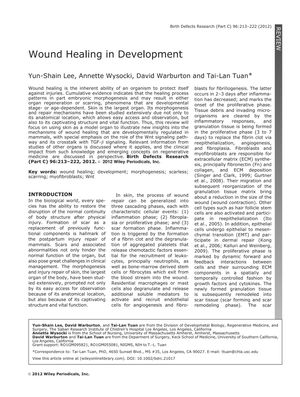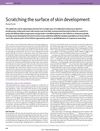Wound Healing in Development: Mechanisms and Regulation
September 2012
in “
Birth Defects Research
”

TLDR Wounds heal without scarring in early development but later result in scars, and studying Wnt signaling could help control scarring.
The document reviewed the mechanisms of wound healing in skin and how these processes are regulated during different developmental stages in mammals. It focused on the role of the Wnt signaling pathway and its interaction with TGF-β signaling in the three phases of skin wound repair: inflammation, proliferation, and scar formation. The review highlighted that wounds in early gestational stages heal without scarring in a hyaluronic acid-rich environment, while later fetal and postnatal wounds heal with scarring. The transition from scarless to scar-forming repair is associated with the development of blood vessels, the inflammatory system, and skin structures like hair follicles. The role of myofibroblasts in scar formation was discussed, and the review suggested that mechanisms of embryonic organ morphogenesis, such as hair follicle formation, might interact with wound healing. The document also explored the similarities between embryonic organ morphogenesis and postnatal wound healing, the role of the extracellular matrix, and the importance of Wnt signaling in both processes. It noted that Wnt signaling is activated by wounding and may be involved in crosstalk with wound-induced factors, with the canonical Wnt pathway associated with scar formation and the non-canonical pathway linked to scarless fetal wound healing. The review also discussed the role of TGF-β isoforms and PAI-1 in scar formation, suggesting that high TGF-β3 activity may be associated with scarless healing. The document concluded that understanding the molecular mechanisms of Wnt signaling and its interaction with other pathways could lead to therapeutic strategies to control scarring, and that different scarring phenotypes like hypertrophic scarring and keloids may require distinct therapeutic approaches.




